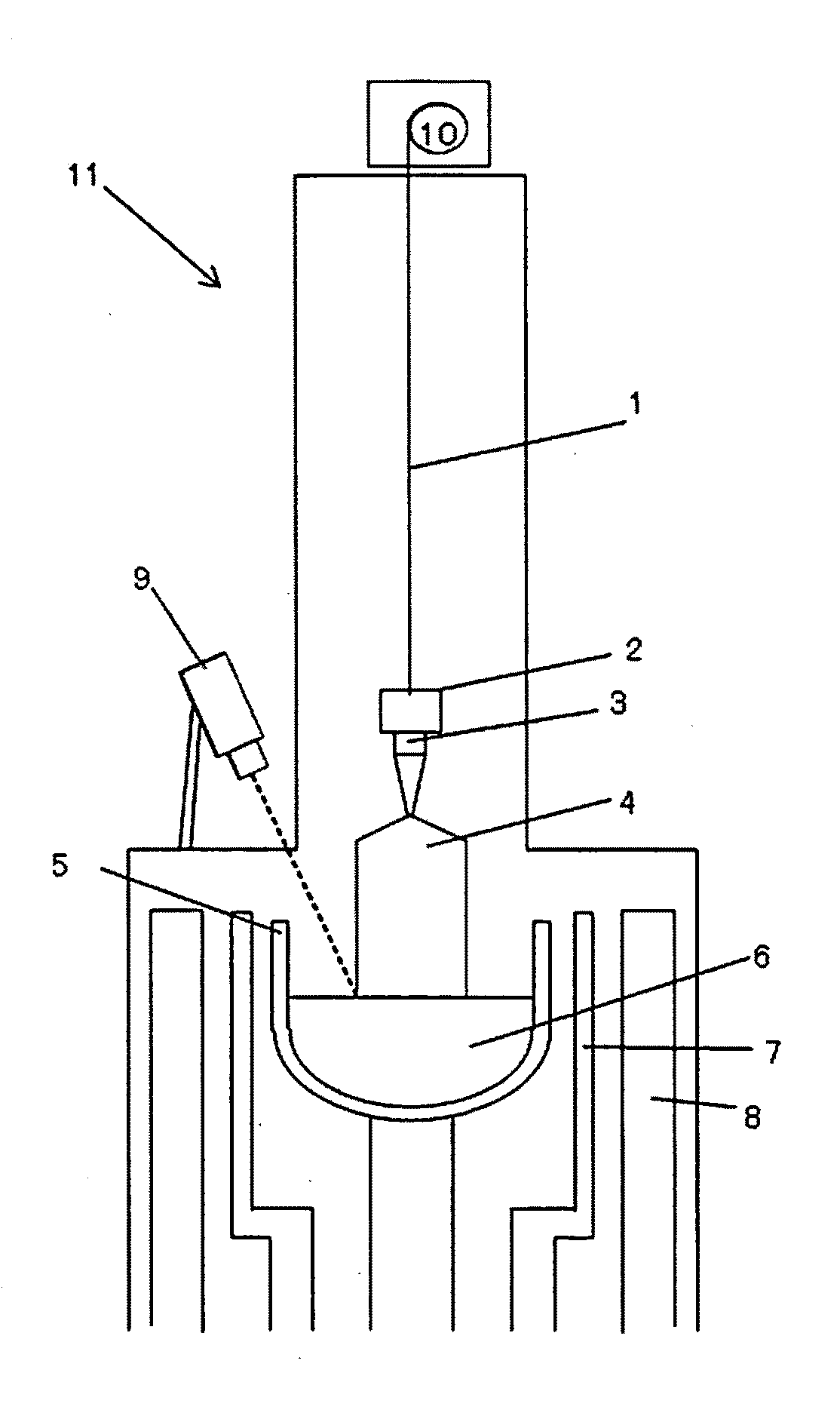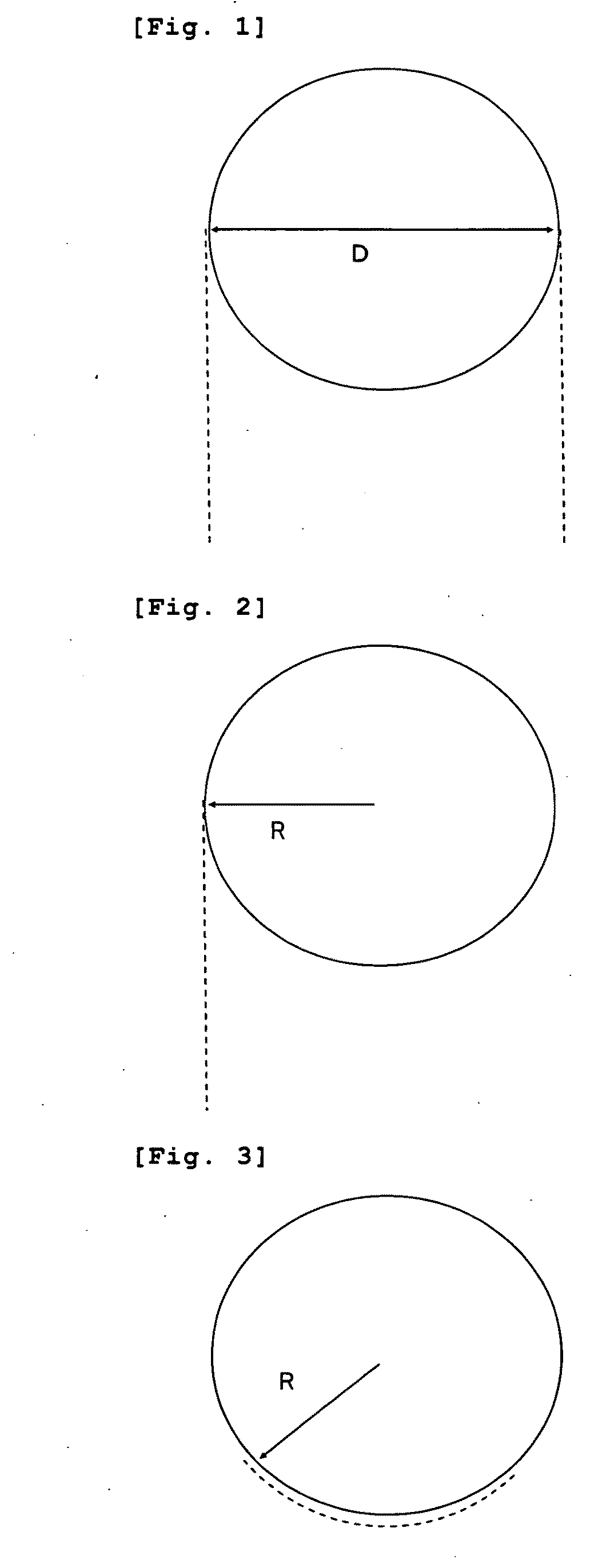Method for detecting the diameter of a single crystal and single crystal pulling apparatus
a technology of pulling apparatus and diameter, which is applied in the direction of chemistry apparatus and processes, instruments, crystal growth process, etc., can solve the problems of affecting the accuracy of measurement. , to achieve the effect of improving the measurement accuracy of the diameter of a large-diameter, enhancing yield, and reducing quality variation
- Summary
- Abstract
- Description
- Claims
- Application Information
AI Technical Summary
Benefits of technology
Problems solved by technology
Method used
Image
Examples
example 1
[0056]A single crystal was produced by using the single crystal pulling apparatus of FIG. 4, performing correction of a diameter detected by the camera by a method according to the flow shown in FIG. 5, and controlling the diameter so as to be a value obtained by the correction. Before production of the single crystal, a relationship between a growth rate and a correction coefficient in a single crystal pulling apparatus to be actually used was obtained in advance (FIG. 7). By setting the length L1 of a straight body at the start of calculation to 5 cm and setting the length L2 of the straight body to 15 cm, a diameter Do detected by the camera between 5 cm and 15 cm and a diameter Dw determined based on the amount of change in weight between 5 cm and 15 cm were detected. After the straight body became 15 cm, correction of the diameter detected by the camera was performed by adding, to the diameter detected by the camera, a value obtained by adding a correction coefficient −1.5 corr...
example 2
[0057]A single crystal was produced by using the same single crystal pulling apparatus as that used in Example 1 by a method similar to that in Example 1, except that the length L1 of a straight body at the start of calculation was set to 5 cm, the length L2 of the straight body was set to 25 cm, and the average interval in which correction was calculated was set to 20 cm, by performing correction of a diameter detected by the camera by adding, to the diameter detected by the camera, a value obtained by addition of a correction coefficient −1.5 corresponding to an actual pulling rate 0.4 mm / min, and controlling the diameter of a single crystal so as to be a value obtained by the correction. As in Example 1, the diameter after production of the crystal was measured in a 40 cm part of the straight body, and diameter variation (standard deviation σ) was evaluated.
example 3
[0062]A single crystal was produced by using the same single crystal pulling apparatus as that in Example 1, setting the average interval (L2−L1) in which correction was calculated to 5 cm, 10 cm, 15 cm, and 20 cm, and controlling the diameter of a single crystal by a method similar to that in Example 1, and a diameter calculation error of the load cell in a 40 cm part of a straight body was examined. The results revealed that an actual error in the weights repeatedly measured by the load cell was 100 g in any of the 5 cm to 20 cm average intervals (L2−L1), and a diameter conversion error in an interval of 10 cm or more was approximately 1 mm or less.
[0063]FIG. 10 is a graph showing the relationship between the average interval (L2−L1) in which correction is calculated and a diameter calculation error of a load cell, the relationship observed in Example 3. It is clear from FIG. 10 that there is not a great difference between the 10 cm average interval (L2−L1) and the 20 cm average i...
PUM
 Login to View More
Login to View More Abstract
Description
Claims
Application Information
 Login to View More
Login to View More - R&D
- Intellectual Property
- Life Sciences
- Materials
- Tech Scout
- Unparalleled Data Quality
- Higher Quality Content
- 60% Fewer Hallucinations
Browse by: Latest US Patents, China's latest patents, Technical Efficacy Thesaurus, Application Domain, Technology Topic, Popular Technical Reports.
© 2025 PatSnap. All rights reserved.Legal|Privacy policy|Modern Slavery Act Transparency Statement|Sitemap|About US| Contact US: help@patsnap.com



